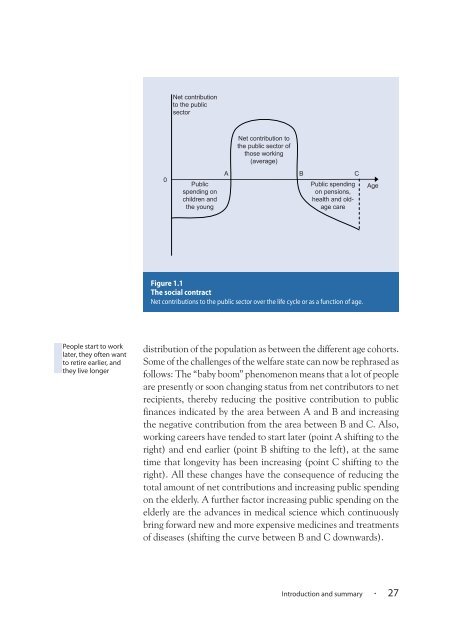The Nordic Model - Embracing globalization and sharing risks
The Nordic Model - Embracing globalization and sharing risks
The Nordic Model - Embracing globalization and sharing risks
Create successful ePaper yourself
Turn your PDF publications into a flip-book with our unique Google optimized e-Paper software.
Net contribution<br />
to the public<br />
sector<br />
Net contribution to<br />
the public sector of<br />
those working<br />
(average)<br />
0<br />
Public<br />
spending on<br />
children <strong>and</strong><br />
the young<br />
A<br />
B<br />
Public spending<br />
on pensions,<br />
health <strong>and</strong> oldage<br />
care<br />
C<br />
Age<br />
Figure 1.1<br />
<strong>The</strong> social contract<br />
Net contributions to the public sector over the life cycle or as a function of age.<br />
People start to work<br />
later, they often want<br />
to retire earlier, <strong>and</strong><br />
they live longer<br />
distribution of the population as between the different age cohorts.<br />
Some of the challenges of the welfare state can now be rephrased as<br />
follows: <strong>The</strong> “baby boom” phenomenon means that a lot of people<br />
are presently or soon changing status from net contributors to net<br />
recipients, thereby reducing the positive contribution to public<br />
finances indicated by the area between A <strong>and</strong> B <strong>and</strong> increasing<br />
the negative contribution from the area between B <strong>and</strong> C. Also,<br />
working careers have tended to start later (point A shifting to the<br />
right) <strong>and</strong> end earlier (point B shifting to the left), at the same<br />
time that longevity has been increasing (point C shifting to the<br />
right). All these changes have the consequence of reducing the<br />
total amount of net contributions <strong>and</strong> increasing public spending<br />
on the elderly. A further factor increasing public spending on the<br />
elderly are the advances in medical science which continuously<br />
bring forward new <strong>and</strong> more expensive medicines <strong>and</strong> treatments<br />
of diseases (shifting the curve between B <strong>and</strong> C downwards).<br />
Introduction <strong>and</strong> summary · 27

















